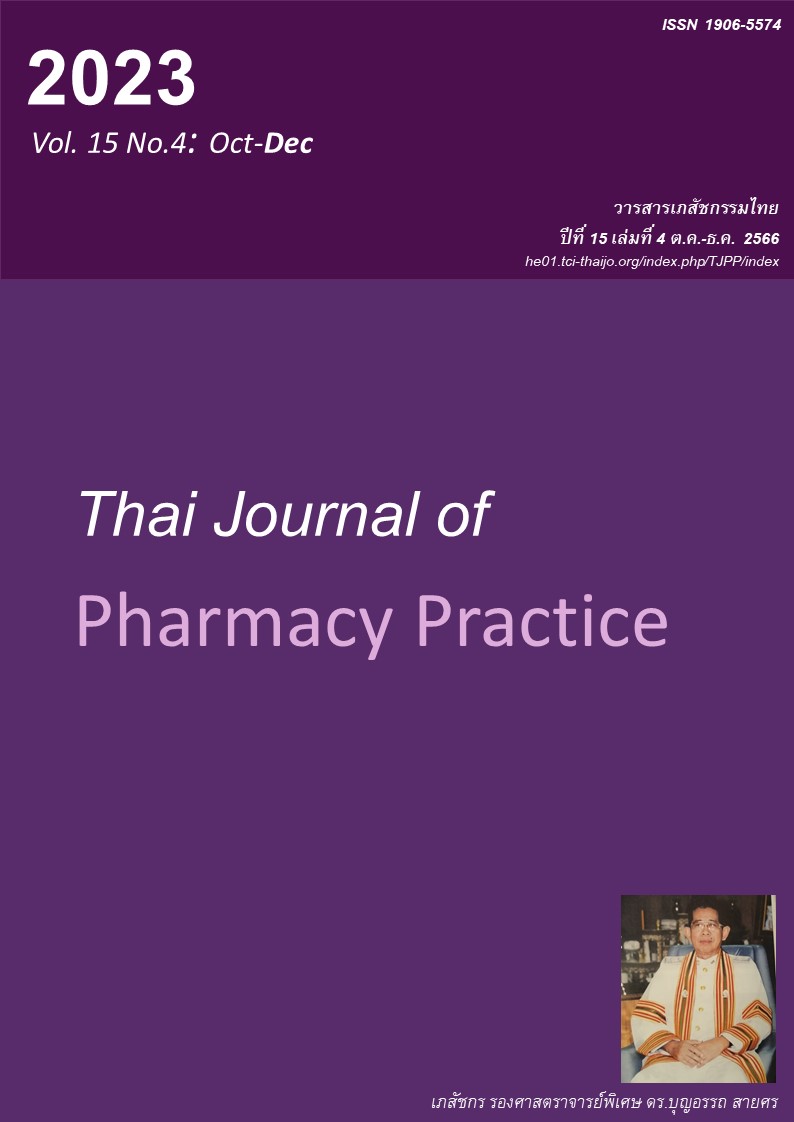ปัจจัยที่สัมพันธ์กับความคลาดเคลื่อนของการสั่งใช้ยาใน ผู้ป่วยนอกโรคไตเรื้อรังของโรงพยาบาลเชียงคำ จังหวัดพะเยา
Main Article Content
บทคัดย่อ
วัตถุประสงค์: เพื่อศึกษาปัจจัยที่สัมพันธ์กับความคลาดเคลื่อนของการสั่งใช้ยาในผู้ป่วยนอกโรคไตเรื้อรัง โรงพยาบาลเชียงคำ จังหวัดพะเยา วิธีการ: การวิจัยเชิงวิเคราะห์แบบตัดขวางครั้งนี้เก็บรวบรวมข้อมูลจากใบสั่งยาของผู้ป่วยโรคไตเรื้อรังแบบย้อนหลังจำนวน 32,260 ใบสั่งยาจากเวชระเบียนอิเล็กทรอนิกส์ ตั้งแต่วันที่ 1 ตุลาคม 2562 ถึง 30 กันยายน 2563 และจากรายงานการเกิดอุบัติการณ์ความเสี่ยงของโรงพยาบาลในช่วงเวลาเดียวกัน การวิเคราะห์ความสัมพันธ์ของการเกิดความคลาดเคลื่อนของการสั่งใช้ยากับปัจจัยต่าง ๆ โดยใช้สถิติ multilevel, mixed model, logistic regression ผลของการวิเคราะห์เมื่อพิจารณาข้อมูลใบสั่งยาในระดับชั้นของหมายเลขประจำตัวโรงพยาบาลของผู้ป่วยแต่ละราย (เนื่องจากผู้ป่วยหนึ่งคนอาจมีใบสั่งยาได้หลายใบ โดยผู้ป่วย 5,838 คนและมีใบสั่งยา 32,260 ใบ) และปรับอิทธิพลของเพศ กลุ่มอายุผู้ป่วย สิทธิ์การรักษา และวันทำงาน ผลการวิจัย: ปัจจัยที่มีผลต่อความคลาดเคลื่อนของการสั่งใช้ยา ได้แก่ ช่วงเวลาการทำงานในเวรดึก 24.00 ถึง 8.00 น. (OR=27.66, 95% CI=1.50-511.46, P<0.03) กลุ่มผู้สั่งยาแพทย์เพิ่มพูนทักษะปีที่ 1 (OR=7.62, 95% CI=4.07-14.27, P<0.001) และโรคร่วมบางโรค ได้แก่ โรคหัวใจเกี่ยวเนื่องกับปอดและโรคการไหลเวียนของปอดและรูปแบบอื่นของโรคหัวใจ (I26-28, I30-52) (OR=3.65, 95% CI=2.09-6.37, P<0.001) สรุป: ปัจจัยที่สัมพันธ์กับการเกิดความคลาดเคลื่อนของการสั่งใช้ยาในผู้ป่วยโรคไตเรื้อรัง ได้แก่ ช่วงเวลาการทำงาน กลุ่มผู้สั่งยา และการมีโรคร่วมที่มีความซับซ้อนหรือการใช้ยาเสี่ยงสูง ผลการศึกษาสามารถใช้เป็นข้อมูลในการบริหารความเสี่ยงของโรงพยาบาล นอกจากนี้ ควรเฝ้าระวังป้องกันการเกิดความคลาดเคลื่อนของการสั่งใช้ยาในผู้ป่วยนอกโรคไตเรื้อรังอย่างสม่ำเสมอ
Article Details

อนุญาตภายใต้เงื่อนไข Creative Commons Attribution-NonCommercial-NoDerivatives 4.0 International License.
ผลการวิจัยและความคิดเห็นที่ปรากฏในบทความถือเป็นความคิดเห็นและอยู่ในความรับผิดชอบของผู้นิพนธ์ มิใช่ความเห็นหรือความรับผิดชอบของกองบรรณาธิการ หรือคณะเภสัชศาสตร์ มหาวิทยาลัยสงขลานครินทร์ ทั้งนี้ไม่รวมความผิดพลาดอันเกิดจากการพิมพ์ บทความที่ได้รับการเผยแพร่โดยวารสารเภสัชกรรมไทยถือเป็นสิทธิ์ของวารสารฯ
เอกสารอ้างอิง
Chanatapaporn P. development of prescribing error program for reporting in Srinagarind hospital. Srina- garin Medical Journal. 2019; 34: 261–70.
Phuktiyanuwut S. comparison of medication error between the new prescribing system and conven- tional prescribing system in outpatients at Chaiya phum. Chiangrai Medical Journal. 2020; 12: 99–113.
Lee JL. Prescribing errors in pediatric outpatient department at a tertiary care hospital in Malaysia. Int J Clin Pharm 2020; 42: 604–9.
Outpatient Pharmacy Department. Annual report of prescribing error in outpatient Chiangkham Hospital. Chiangkham: Chiangkham Hospital; 2020.
World Health Organization. Medication errors: techni cal series on safer primary care. Geneva: WHO; 2016.
Roy DA, Shanfar I, Shenoy P, Chand S. Drug-related problems among chronic kidney disease patients: a clinical pharmacist led study. Int J Pharm Res 2020; 12: 79–84.
Garedow AW, Mulisa Bobasa EM, Wolide AD, Dibaba FK, Fufa FG, Tufa BI, et al. Drug-related problems and associated factors among patients admitted with chronic kidney disease at Jimma University Medical Center, Jimma Zone, Jimma, Southwest Ethiopia: a hospital-based prospective observational study. Int J nephrol 2019; 2019: 1504371. doi: 10.1155/2019/1 504371.
Belaiche S, Romanet T, Allenet B, Calop J, Zaoui P. Identification of drug-related problems in ambulatory chronic kidney disease patients: a 6-month prospec tive study. J Nephrol. 2012; 25: 782–8.
Subeesh VK, Abraham R, Satya Sai MV, Koonisetty KS. Evaluation of prescribing practices and drug-related problems in chronic kidney disease patients: a cross-sectional study. Perspect Clin Res. 2020; 11: 70–4.
Bureau of Policy and Strategy. ICD-10-TM: Interna tional statistical classification of diseases and related health problems, Thai modification. Nonthaburi: Ministry of Public Health; 2009.
Kitikannakorn N. Toyai P. Prescribing error [online]. 2020 [cited Feb 3, 2022]. Available from: cpe.phar macy.cmu.ac.th/member/files_journal/1003-1-000-0 01-03-2563finalize_prescribing error_30.3.63.pdf
National Coordinating Council for Medication Error Report and Prevention (NCC MERP). NCC MERP taxonomy of medication errors [online]. 2001 [cited Feb 3, 2022]. Available from: www.nccmerp.org/ sites/default/files/taxonomy2001-07-31.pdf
Healthcare Accreditation Institute (Public Organiza tion). Patient safety goal: SIMPLE Thailand 2018. Bangkok: Famous and Successful; 2018.
Aljuaid M, Alajman N, Alsafadi A, Alnajjar F, Alsh aikh M. Medication error during the day and night shift on weekdays and weekends: a single teaching hospital experience in Riyadh, Saudi Arabia. Risk Manag Healthcare Policy. 2021; 14: 2571–8.
Wondmieneh A, Alemu W, Tadele N, Demis A. Medication administration errors and contributing factors among nurses: a cross sectional study in tertiary hospitals, Addis Ababa, Ethiopia. BMC Nurs. 2020; 19: 4. doi: 10.1186/s12912-020-0397-0.
Alemdar DK, Aktaş YY. Medical error types and causes made by nurses in Turkey. TAF Prev Med Bull 2013; 12: 307–14.
Johnson AL, Jung L, Brown KC, Weaver MT, Ric- hards KC. Sleep deprivation and error in nurses who work the night shift. J Nurs Adm. 2014; 44: 17–22.
Ramadan MZ, Al-Saleh KS. The association of sleep deprivation on the occurrence of errors by nurses who work the night shift. Curr Health Sci J 2014; 40: 97–103.
Jankowski J, Floege J, Fliser D, Böhm M, Marx N. Cardiovascular disease in chronic kidney disease pathophysiological insights and therapeutic options. Circulation. 2021; 143: 1157–72.
Lai W, Zhao X, Yu S, Mai Z, Zhou Y, Huang Z, et al. Chronic kidney disease increases risk of incident HFrEF following percutaneous coronary intervention. Front Cardiovasc Med. 2022; 9: 856602. doi: 10.33 89/fcvm.2022.856602.
Hakopian NN, Gharibian D, Nashed MM. Prognos tic impact of chronic kidney disease in patients with heart failure. Perm J. 2019; 23: 18-273. doi: 10.781 2/TPP/18.273.
Lesar TS, Briceland L, Stein DS. Factors related to errors in medication prescribing. JAMA. 1997; 277: 312–7.
Healthcare Accreditation Institute. NRLS: National Reporting and Learning System. Common clinical risk incident: medication and blood safety [online]. 2018 [cited Feb 3, 2022]. Available from: www.bph. moph.go.th/wp-content/uploads/tqm/nrls/risk-nrls.pdf.


